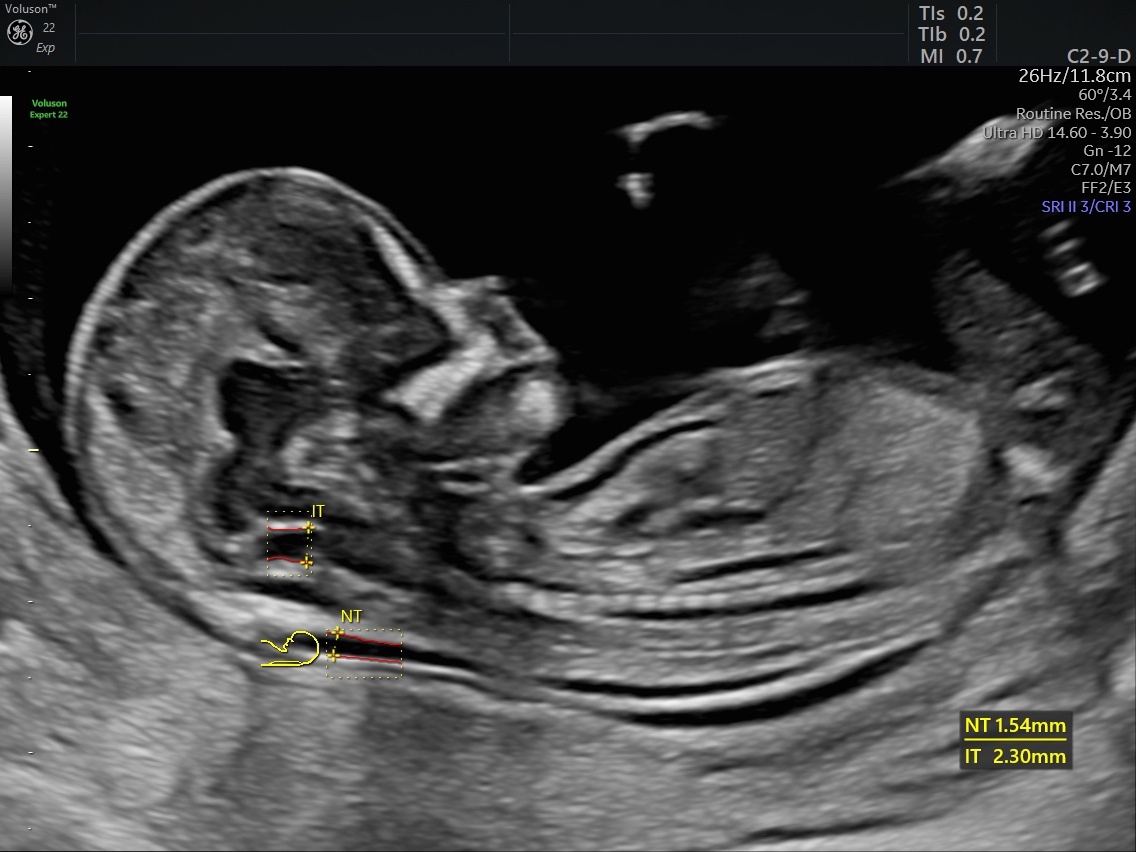Part of routine prenatal care includes screening for Down syndrome, or trisomy 21, which is the most common type of trisomy disorder. This condition occurs in about 1 out of 691 births, according to the Children's Hospital of Philadelphia.
Advanced age increases the risk of carrying a trisomy fetus; however, screening should be offered to every pregnant patient regardless of age. A patient may decline the testing, but they should only do so after thorough counseling by someone well versed in the disorder and the array of tests available. Care teams can then tailor the specific type of screening to the patient's preference while factoring in the gestational age of the pregnancy.
What First-Trimester Ultrasound Reveals About Fetal Health
Ideal circumstances may allow physicians to identify trisomy 21 early in pregnancy, at about 10-13 weeks. This is when the first trimester combined trisomy screening is conducted, including ultrasound and a blood test to measure pregnancy-associated plasma protein-A and free-beta or total human chorionic gonadotropin (hCG).
As part of the first-trimester screening, ultrasound measures the nuchal translucency or the clear space at the back of the fetal head. In addition to screening for nuchal translucency, the first-trimester ultrasound provides valuable information concerning the dating of the pregnancy, fetal anatomy and viability, and the presence or absence of multiples. The 13-week anomaly scan looks for major defects in the cranial bones, ventricles, spine, cord insertion, extremities and internal organs.

Specific markers for fetal abnormalities stemming from aneuploidy, such as the shortened or absent nasal bone or an abnormal cardiac exam in the first trimester, can alert healthcare providers of potential problems. Patients should receive counselling about any discoveries and go on to have an additional evaluation if they choose.
Additional Testing in the Second and Third Trimesters
If the results of the blood test reveal an abnormality, a pregnant patient may choose to proceed with definitive diagnostic testing for fetal karyotype via either chorionic villus sampling (CVS) or amniocentesis. Although these are invasive tests and pose some risks, they allow for the opportunity to make plans for the pregnancy—or a child's additional health needs—early on.
If a pregnant patient presents with trisomy later in pregnancy, they may opt for the quad blood screening test. This exam measures AFP, unconjugated estriol, hCG and inhibin-A. The quad screen is typically offered between 15 and 20 weeks of gestational age.
The second trimester 18-22 week anatomy scan remains the optimal time for a full review of fetal anatomy. Soft markers for aneuploidy, such as a thickened nuchal fold, choroid plexus cysts, echogenic bowel, shortened long bones and echogenic intracardiac foci, should prompt further investigation, especially when found clustered in a single fetus. If the patient wishes, physicians can follow up on these findings with chromosomal analysis. Some patients may choose to integrate both first-trimester screening and the quad screen to improve the detection rate of trisomy 21.

The Future of Trisomy 21 Screening
Another relatively new test — known by several names, including cell-free DNA, non-invasive prenatal screening and non-invasive prenatal testing — screens for trisomy 21 as well as other genetic aneuploidies. It is highly accurate and can be offered as early as 10 weeks gestational age. Despite its high sensitivity and specificity, as with other trisomy screening options, physicians should offer pregnant patients a definitive diagnostic evaluation with either CVS or amniocentesis if the result is abnormal.
It is possible to effectively screen for trisomy 21 throughout pregnancy, starting in the first trimester, by combining blood tests with ultrasound. For physicians who are looking to improve their skills in offering a Down syndrome diagnosis during pregnancy, the Fetal Medicine Foundation provides global access to nuchal translucency training, competency certification and risk calculator software to support healthcare professionals and patients.





